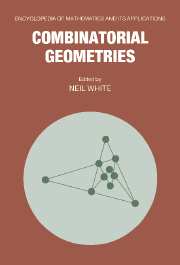Book contents
- Frontmatter
- Contents
- List of Contributors
- Series Editor's Statement
- Preface
- 1 Coordinatizations
- 2 Binary Matroids
- 3 Unimodular Matroids
- 4 Introduction to Matching Theory
- 5 Transversal Matroids
- 6 Simplicial Matroids
- 7 The Möbius Function and the Characteristic Polynomial
- 8 Whitney Numbers
- 9 Matroids in Combinatorial Optimization
- Index
9 - Matroids in Combinatorial Optimization
Published online by Cambridge University Press: 05 May 2013
- Frontmatter
- Contents
- List of Contributors
- Series Editor's Statement
- Preface
- 1 Coordinatizations
- 2 Binary Matroids
- 3 Unimodular Matroids
- 4 Introduction to Matching Theory
- 5 Transversal Matroids
- 6 Simplicial Matroids
- 7 The Möbius Function and the Characteristic Polynomial
- 8 Whitney Numbers
- 9 Matroids in Combinatorial Optimization
- Index
Summary
Matroids enter combinatorial optimization problems at various levels. Whitney's (1935) motivation to introduce matroids as combinatorial objects in their own right stemmed from his interest in approaching the Four-Color Problem algebraically and combining the combinatorial and algebraic-geometric aspects of graphs into the notion of a matroid.
Graphs furnish the most important models for combinatorial optimization problems. Thus it is natural to ask to what extent graph properties actually are properties of the underlying matroid and to study more general classes of matroids that enjoy, for example, the ‘max-flow-min-cut’ property of network flows (cf. Seymour 1977). This approach leads to fundamental structural questions about matroids per se which, nevertheless, have many practical implications. One of the foremost results in this area is Seymour's (1980) decomposition theory for regular matroids exhibiting regular matroids as being essentially built up by graphic and cographic matroids. As a consequence, efficient procedures can be developed to test whether a matrix is totally unimodular or whether certain linear programs actually are (better tractable) network problems (see, e.g., Welsh 1982 and Bixby 1982 for an introduction into this aspect of matroid theory).
Matroids also compose the combinatorial structure of linear programming (Minty 1966, Rockafellar 1969). Indeed, pivoting in linear programming may be carried out purely ‘combinatorially’ (Bland 1977).
- Type
- Chapter
- Information
- Combinatorial Geometries , pp. 161 - 210Publisher: Cambridge University PressPrint publication year: 1987
- 16
- Cited by



